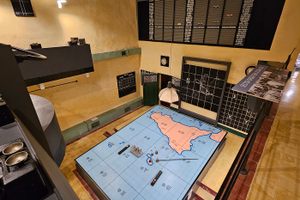
At the start of World War II, the Allied forces immediately recognized that the islands of Malta would be strategically important. Located in the center of the Mediterranean Sea just south of Italy, the islands could be used both to control shipping and to command landing forces in Southern Europe. Hence, in 1940, the U.K. military secretly excavated a set of tunnels 150 feet under Valletta, which are now called the Lascaris War Rooms.
This complex housed the British military’s headquarters and was initially used to coordinate the military defense of the island, particularly the air defenses, as the Axis forces heavily bombed the islands starting in June 1940. A couple of the larger rooms within the complex, such as the two-story Sector Operations Room, had tables with maps that could be used to track Allied and Axis airplanes, while other rooms contained communications equipment for coordinating the islands’ defenses. Later in the war, the Allied commanders planned and coordinated the invasion of Sicily (Operation Husky) within another two-story room within the complex that featured a giant map of Sicily.
After World War II ended, the complex continued to be militarily important. First, the British Navy used the tunnels as their Mediterranean Fleet Headquarters. Then, starting in 1967, the underground complex was used by NATO to track the movement of submarines through the Mediterranean Sea. The complex was closed in 1977.
In 2009, the Malta Heritage Trust began restoration works on the underground compound, which now operates as a museum. The rooms mainly contain items from World War II, including the large maps used for tracking plane movements and coordinating the military forces, the vintage telephone and radio equipment, and the boards used to track the activities of the Allied pilots. The room used for planning Operation Husky even contain mannequins of General Eisenhower and the other generals and admirals involved in the invasion. This restoration has truly recreated the atmosphere of the complex during World War II.
0 comments:
Post a Comment